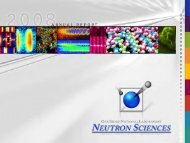ARCS materials - Spallation Neutron Source - Oak Ridge National ...
ARCS materials - Spallation Neutron Source - Oak Ridge National ...
ARCS materials - Spallation Neutron Source - Oak Ridge National ...
Create successful ePaper yourself
Turn your PDF publications into a flip-book with our unique Google optimized e-Paper software.
8490 C P Adams et al<br />
for various values of Ei are shown in figures 2(a) and 2(b) and resemble the more familiar<br />
constant-E and constant-Q triple-axis scans. Peaks are resolved to high energies (>200 meV)<br />
in both types of cut. The dispersion, which is quite steep in comparison to the Qc-resolution, is<br />
measured with a resolution corrected fit to the peaks in constant-E cuts as shown in figure 2(a).<br />
The constant-Qc cuts show damped magnons with a significant linewidth that increases with<br />
energy. Along the a-axis, similar spin-wave behaviour and damping have been observed with<br />
triple-axis measurements [13] but the zone boundary energy is only 30 meV, much less than<br />
the c-axis spin-wave energies in figures 2(a) and 2(b).<br />
Intensity (mb meV −1 sr −1<br />
)<br />
(a)<br />
0.4<br />
0.2<br />
0.0<br />
x10<br />
x 3<br />
h¯ ω=250 meV<br />
h¯ ω=155 meV<br />
h¯ ω=<br />
77.5 meV<br />
1.2 1.6 2.0 2.4 2.8<br />
Q c (c*)<br />
(b)<br />
0.6<br />
0.4<br />
0.2<br />
0.0<br />
Q c =1.6 c*<br />
Q c =1.74 c*<br />
Q c =1.87 c*<br />
50 100 150 200<br />
Energy (meV)<br />
Figure 2. (a) Constant-E and (b) constant-Qc cuts showing the c-axis magnons. Cuts are taken<br />
from data reduced to the (Qc,E) plane and have been offset vertically (the thick dashed lines<br />
represent zero intensity above the background). Two sets have been rescaled as indicated. The<br />
data in (b) have had the background removed by subtraction of a nearby non-magnetic cut. The<br />
solid lines are the resolution-corrected scattering cross-sections (described in more detail in a later<br />
section).<br />
The c-axis spin-wave dispersion, as measured by Gaussian fits to constant-E cuts, is shown<br />
in figure 3.<br />
The 3D classical, NN Heisenberg model has a Hamiltonian of the form<br />
H =− Jij Si · Sj .<br />
Combining this with the known low-T AFM structure of FeGe2 gives the spin-wave dispersion<br />
[20]:<br />
¯hωQ = 4S({JFM[1 − cos(πl)] − 2JAF M[1 − cos(πh) cos(πk)]}<br />
×{JFM[1 − cos(πl)] − 2JAF M[1 + cos(πh) cos(πk)]}) 1/2<br />
(1)<br />
where the spin-wave energy is ¯hωQ, S is the on-site spin, JFM is the c-axis exchange constant,<br />
JAF M is the [110] exchange constant, and h, k, and l express Q in terms of reciprocal-lattice<br />
coordinates. Triple-axis measurements [13] have shown a gapless (

















